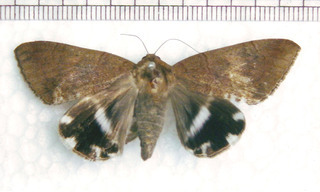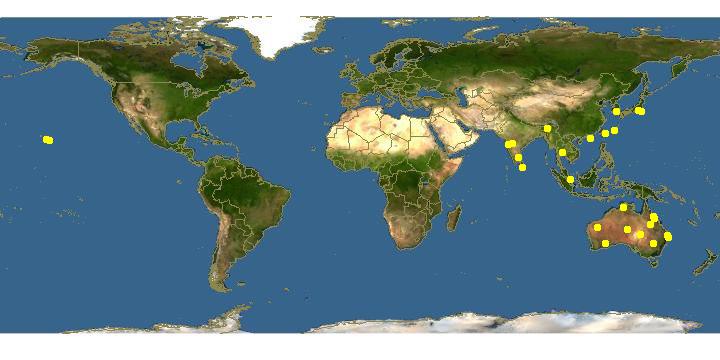|
Crop Knowledge Master
|

|
Achaea janata
(Linnaeus)
|
|
Croton Caterpillar
|
Authors
Ronald F.L. Mau, Extension Entomologist
Jayma L. Martin Kessing, Educational Specialist
Department of Entomology
Honolulu, Hawaii
Updated by: J.M. Diez April 2007
HOSTS
This caterpillar feeds on many different species of plants. castor bean and croton are preferred hosts. Occasional hosts include banana, cabbage, Chinese cabbage, crown of thorns,
Ficus,
macadamia, mustard, poinsettia, rose, sugarcane and tomato as well as some legumes, teas, and other
Brassica
species.
DISTRIBUTION
This moth is widespread throughout the tropical and subtropical Pacific, in Australia, and the Orient. It was first collected in Hawaii in 1944 and is now present on all major islands.
DAMAGE
Caterpillars feed on leaves of hosts. During population outbreaks, larvae consume most of the foliage leaving just the veins and petioles.
BIOLOGY
The entire life cycle from egg to adult takes place in 48-50 days (French, 1950). The population of this moth fluctuates from year to year in abundance and seasonal occurrence.
EGGS
The pale to dark green, hemispherical shaped eggs are 1/25 inch in diameter and have deep striations radiating from a central point giving the egg a sculptured appearance. They are deposited singly or in clusters on either leaf surface. Eggs hatch in 3 to 4 days.
LARVAE
Caterpillars
have three distinct body regions, the head, 3 thoracic segments and 10 abdominal segments. Each thoracic segment and abdominal segments 5, 6, and 10 bear a pair of legs. Although these caterpillars are the "naked" type, they do have some hairs on their body. There are 6 caterpillar stages, or instars, before pupation. The first stage caterpillars are translucent yellowish-brown in color and about 1/8 inch in length. The next 4 caterpillar stages are variable in color ranging from brownish orange to grayish brown. When fully grown, the caterpillars are about 2-1/2 inches long. Their grayish orange body has a broken black stripe running along the length of each side. There are four white spots on the head of this caterpillar and white spots on the sides of the abdominal legs. A hump located on the back of the caterpillar towards the rear, has two bright red-orange spots. Larvae can be mistaken for that of the guava moth, Anua indiscriminata. They differ mainly in the spotting of the head, sides of the abdominal legs and the color of the "hump". During the last larval stage, also called the "prepupa" by some authors, the caterpillar does not feed and decreases slightly in size.
Each larval stage lasts about 2 days except for the last stage that lasts for about 4 days. The duration of the larval period is influenced by the amount of food available, plentiful food supply lengthens the caterpillar stage (Muthukrishman and Pandian, 1984).
PUPAE
Pupae
are reddish brown, about 1/4 inch in length, and covered by a silken cocoon. Mature larvae build cocoons on or off the plant. When caterpillars drop to the ground before spinning their cocoon, the silken threads become covered with loose particles of soil and litter. Cocoons found under fallen leaves and debris appear as clumps of soil. Caterpillars that remain on the plant to pupate spin their cocoon within a folded leaf. These cocoons have the appearance of a dead, shrunken leaf.
The duration of the pupal stage is influenced by temperature with warmer temperatures shortening the development time (Muthukrishman and Pandian, 1984).
ADULTS
The adult
moth
is 5/8 inch long with a wingspan of 1-1/2 to 2 inches. The forewings are brownish-gray and the hindwings gray with a bright spot of black and white near the tips.
Females start laying eggs 2 to 5 days after emerging from the pupa and lay an average of 1305 eggs during their lifetime (Karmawati and Tobing, 1988). Eggs are laid during the night since the moths are nocturnal.
MANAGEMENT
NON-CHEMICAL CONTROL
Several parasites of the croton caterpillar are present in Hawaii. The Ichneumonid wasp,
Hyposoter exiguae
(Vier.) was recovered from larvae and the Tachnid wasps,
Blondelia (Eucelatoria) armigera
(Coq.) and
Chaetogaedia monticola
(Big.) were recovered from larvae and pupae on castor (Sakimura, 1949). The egg parasite,
Trichogramma minutum
(Riley), is also present in Hawaii (Herting and Simmonds, 1976) and their eggs were present in all croton caterpillar eggs collected in 1945 (Sakimura, 1949). Other
Trichogramma
species have been reported to parasitize 50-83% of croton caterpillar eggs (Salvador,
et. al
., 1986).
Introductions of the egg parasite,
Telenomus proditor,
into India was successful in providing limited control of croton caterpillars (Thobbi,
et. al.
, 1976).
Some control has been achieved using entomogenous microorganisms like fungi, bacteria and viruses. Kamat,
et. al.
(1978) achieved 80-90% mortality using the fungus,
Nomuraea rileyi
(Farl.) Sms. Deshpande and Ramakrishnan (1982) found the bacterial agent,
Bacillus thuringiensis
variety
kurstaki
effective on croton caterpillar. However the
B.t. varieties sotto, entomocidus
and
aizawai
were not as effective against later caterpillars stages.
CHEMICAL CONTROL
Several chemical insecticides are effective against the croton caterpillar. Pyrethroids insecticides are more effective than natural pyrethrins (Singh,
et. al
.,1987). Neem seed kernel suspensions are effective feeding deterrents on castor (Chari and Muralidharan, 1985).
REFERENCES
Bilapate, G. G. 1982. Studies on Population Growth of
Achaea janata
Fabricius on Castor. J. Maharashtra Agric. Univ. 12(3): 388-389.
Chari, M. S. and C. M. Muralidharan. 1985. Neem (
Azadirachta indica
Linn.) as Feeding Deterrent of Castor Semilooper (Achaea janata Linn.). J. Ent. Res. 9(2): 243-245.
Deshpande, A. D. and N. Ramakrishnan. 1982. Pathogenicity of Certain Serotypes of
Bacillus thuringiensis
Berliner Against
Achaea janata
L. Entomon. 7(2): 239-249.
French, E. W. 1950. A Study of the Biology and Morphology of
Achaea janata
(Linn.), a Cotocaline Moth, as It Occurs in Hawaii. M.S. Thesis. University of Hawaii.
Herting, B. and F. J. Simmonds. 1976. A Catalogue of Parasites and Predators of Terrestrial Arthropods. Section A, Vol. VII, Lepidoptera, Part 2: 1-221.
John, A. and D. Muraleedharan. 1989. Biology and Morphometrics of Castor Semilooper,
Achoea janata
Linn. (Lepidoptera: Noctuidae). Uttar Pradesh J. Zool. 9(1): 48-55.
Kamat, M. N., S. R. Bagal, V. V. Thobbi, V. G. Rao and C. H. Phadke. 1978. Biological Control of Castor Semi-Looper Through the Use of Entomogenous Fungus
Nomuraea rileyi.
Indian J. Bot.1(1/2): 69-74.
Karmawati, E. and S. L. Tobing. 1988. Laboratory Biology of
Achaea janata
L. Castor Large Semi-Loopers. Industrial Crops Res. J. 1(1): 37-42.
Muthukrishman, J and T. J. Pandian, 1984. Effects of Interaction of Ration and Temperature on growth and Bioenergetics of
Achaea janata
Linnaeus (Lepidoptera: Noctuidae). Oecologia. 62(2): 272-278.
Sakimura, K. 1949. Notes and Exhibitions. Review of Applied Entom. 37: 78-79.
Sakimura, K. 1946. Notes and Exhibitions. Proc. Hawaii. Ent. Soc. 12(3): 463-492.
Salvador, A. C., I. F. Nunez, H. Nagaraja, P. T. Easaw and T. Vanialingam. 1986. Record of Egg Parasites of the Castor Semi-Looper
Achaea janata
(L.) in the Philippines. Philippine Entomologist. 6(6): 589-593.
Singh, D. S., P. Sircar and S. Dhingra. 1987. Relative Resistance of Hairy and Non-Hairy Caterpillars to Synthetic Pyrethroids. J. Ent. Res. 11(2): 145-149.
Thobbi, V. V., B. U. Singh, A. U. Hassan, S. Sarver, N.G.P. Rao. 1976. Biological Control of Castor Semilooper. Indian Farming. 26(6): 15-17.
Prasad, D. R. and S. Prasad. 1984.
Achaea janata
Linn. (Lepidoptera: Noctuidae) as a Pest of Ficus species. Indian J. Agric. Sci. 54(3): 216.
MAR/1991 revised MAY/1992.
A-JANATA
| 


